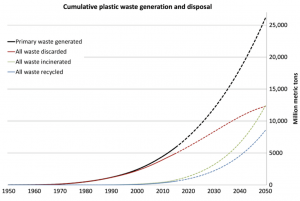
How to Solve Our Waste Exporting Problem
By: Jack Miklaucic, Sophomore in Emory College, Environmental Science and PPL double-major
The United States produces the third most waste per capita in the world, coming in at 25.9 metric tons per person and 8.4 billion metric tons per year (1). This gargantuan amount of waste demands the question of where it is stored. Unfortunately, the answer is that waste produced in the U.S. is overwhelmingly sent abroad. Less than 10% of plastic waste in the U.S. is recycled, with over half of it historically being sent to China and other low and middle income countries (2). While countries around the world are on the whole improving their waste management, the fact remains that as much as 3% of the plastic waste the U.S. sends elsewhere is littered or illegally dumped, with as much as 90% of it being improperly managed (2). Even though countries like China, Vietnam, and Thailand have made recent efforts to reduce the amount of plastic waste they accept, the U.S. still sends more waste abroad than ever, now to countries including Bangladesh, Laos, Nigeria, and Senegal (3).

This exported waste has dire environmental and human health impacts. Contaminated water supplies, crop death, respiratory illness (from exposure to burning plastic), greenhouse gas emissions, and habitat loss are some of the many problems that countries which accept waste exports face (3). These issues combined lead to between 400,000 and 1 million premature deaths each year (4). Despite these findings, corporations in the U.S. responsible for vast amounts of waste exports continue to lobby Congress and private entities for supportive regulations that permit their continued waste production (4). In order to reduce the scale of these consequences we must take immediate and decisive action to reduce the amount of waste exported.
How, then, can we reduce waste exports? For individuals, the answer is simple: reduce our waste generation. It is critical to work towards large-scale solutions that shift the current waste economy towards a more sustainable model, including advocating for policies that incentivize the reuse of materials, mandate food waste composting, and otherwise working towards achieving corporate change in their modes of production (5). The UK’s tax on products with over 30% virgin (non-recycled) plastic and Korea’s food waste initiative, which has led to more than 95% of waste being recycled into compost, are great examples of successful programs (5). However, these efforts can and should be combined with personal action. Consuming less and consuming better are two extremely important ways to begin the transition to a circular economy, one that does not constantly demand the input of new resources and thus produce vast amounts of waste.
The fact that in most locations in the U.S., our waste is carted away by municipal services has largely absolved us from carefully considering where our waste really goes (6). At Emory, we are fortunate enough to have more knowledge through programs like OSI’s Follow the Waste campaign, knowledge that helps us make better choices. However, there is always room for improvement in both our home lives and our lives as students at Emory. Through simple steps like using a reusable water bottle and utensils, ordering food from locations with reusable container options, and purchasing groceries and other necessities with reusable shopping bags, we can significantly reduce our own waste. Let’s absolutely take on the system and change how waste is produced and disposed of in this country—but during that journey, let’s do our part as well.
Works Cited
- Byrnes, H., & Frohlich, T. (2019, July 12). Canada produces the most waste in the world: The US ranks third. USA Today. Retrieved January 28, 2021.
- Parker, L. (2020, October 30). U.S. generates more plastic trash than any other nation, report finds. National Geographic. Retrieved January 28, 2021.
- McCormick, E., Fullerton, J., Gee, A., Simmonds, C., Murray, B., Fonbuena, C., . . . Saraçoğlu, G. (2019, June 17). Where does your plastic go? Global investigation reveals America’s dirty secret. The Guardian. Retrieved January 28, 2021.
- Harvey, F. (2019, May 13). Mismanaged waste ‘kills up to a million people a year globally’. The Guardian. Retrieved January 28, 2021.
- McGinty, D. (2020, August 06). How to build a circular economy. World Resources Institute. Retrieved February 04, 2021.
- Varkkey, H. (2019, July 29). By exporting trash, rich countries put their waste out of sight and out of mind. CNN. Retrieved January 28, 2021.
